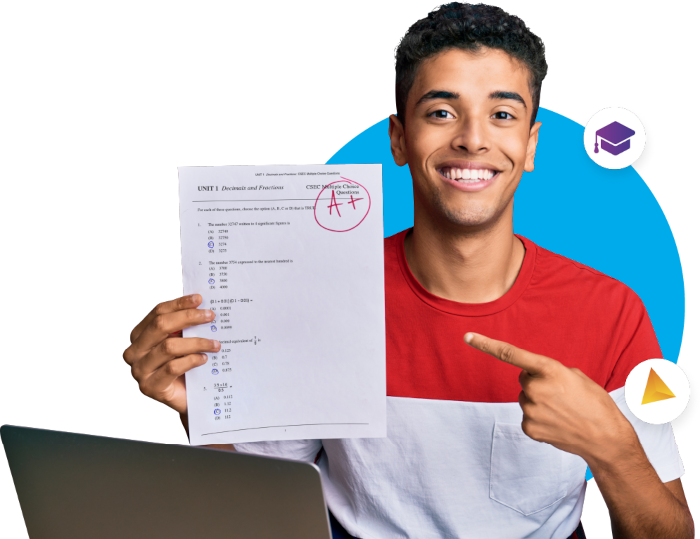Our premium, interactive, 1-on-1 math tutoring will equip your teen to turn their Trigonometry struggles into As and confidence.
Apply Now
Our premium, interactive, 1-on-1 math tutoring will equip your teen to turn their Trigonometry struggles into As and confidence.
Apply Now

Trigonometry is at the intersection of Geometry and Algebra.
Trigonometry is a very interesting type of math because it's the intersection of Geometry and Algebra. Trigonometry is all about the relationship between the measures of angles (often in a triangle) and the lengths of sides.It introduces your child to new functions - trigonometric functions (sine, cosine, etc). Those functions don’t work like other functions in math. For polynomials and exponential functions, you can simply compute the values by performing the algebraic operations on the numbers. Trigonometric functions don’t work that way.
Your child needs to learn how to quickly find some key trig values (using the unit circle) and use the calculator to find the rest.
Oh - have I mentioned that trigonometric functions are periodical and infinite?
That means they repeat forever.
Moreover, many concepts in Trigonometry are not about solving.
Apply Now

Trigonometry is at the intersection of Geometry and Algebra.
Trigonometry is a very interesting type of math because it's the intersection of Geometry and Algebra. Trigonometry is all about the relationship between the measures of angles (often in a triangle) and the lengths of sides.It introduces your child to new functions - trigonometric functions (sine, cosine, etc). Those functions don’t work like other functions in math. For polynomials and exponential functions, you can simply compute the values by performing the algebraic operations on the numbers. Trigonometric functions don’t work that way.
Your child needs to learn how to quickly find some key trig values (using the unit circle) and use the calculator to find the rest.
Oh - have I mentioned that trigonometric functions are periodical and infinite?
That means they repeat forever.
Moreover, many concepts in Trigonometry are not about solving.
Apply Now
They’re puzzle-like. Many are inverse.
The puzzle concepts are the concepts that you don’t solve to get the value of x but rather to prove, derive or verify something. Example: trigonometric identities.
The inverse problems challenge your child - they require backwards thinking, which most students have hard time with. For example, your child might be used to triangles. Finding the area or the angles. But the law of sines (a topic in trigonometry) deals with how triangles are shaped.
Here is the key difference: the question might not be “what is the measure of angle A?” but rather “Can a triangle that fits the description be formed?” or even “How many triangles like that can be formed?” These types of questions require higher analytical thinking skills than solving for x.
Apply Now
The puzzle concepts are the concepts that you don’t solve to get the value of x but rather to prove, derive or verify something. Example: trigonometric identities.
The inverse problems challenge your child - they require backwards thinking, which most students have hard time with. For example, your child might be used to triangles. Finding the area or the angles. But the law of sines (a topic in trigonometry) deals with how triangles are shaped.
Here is the key difference: the question might not be “what is the measure of angle A?” but rather “Can a triangle that fits the description be formed?” or even “How many triangles like that can be formed?” These types of questions require higher analytical thinking skills than solving for x.
Apply Now



They’re puzzle-like. Many are inverse.
The puzzle concepts are the concepts that you don’t solve to get the value of x but rather to prove, derive or verify something. Example: trigonometric identities.
The inverse problems challenge your child - they require backwards thinking, which most students have hard time with. For example, your child might be used to triangles. Finding the area or the angles. But the law of sines (a topic in trigonometry) deals with how triangles are shaped.
Here is the key difference: the question might not be “what is the measure of angle A?” but rather “Can a triangle that fits the description be formed?” or even “How many triangles like that can be formed?” These types of questions require higher analytical thinking skills than solving for x.
Apply Now
The puzzle concepts are the concepts that you don’t solve to get the value of x but rather to prove, derive or verify something. Example: trigonometric identities.
The inverse problems challenge your child - they require backwards thinking, which most students have hard time with. For example, your child might be used to triangles. Finding the area or the angles. But the law of sines (a topic in trigonometry) deals with how triangles are shaped.
Here is the key difference: the question might not be “what is the measure of angle A?” but rather “Can a triangle that fits the description be formed?” or even “How many triangles like that can be formed?” These types of questions require higher analytical thinking skills than solving for x.
Apply Now
Trigonometry Challenges
We Will Help Your Teen Overcome.
Big homework-test gap
Many students feel that they understand the concepts when they are explained in class and are able to solve a lot (or all) homework problems. Yet, they struggle on tests.Some students are able to score 100% on homework and still fail tests.
How is that possible?
The problems on the tests tend to be more complicated, with extra steps, different wording or different twists.
Apply Now


Not enough covered in class
In your child’s class, the teacher likely shows 3-5 problems and hands out homework. I can say that with certainty because we see this over and over, with vast majority of students we talk to. It's prevalent.Showing 3-5 problems is not nearly enough.
Every topic in Algebra 2 has from 3 to 7 problem types. For every problem type, your child will have to deal with several different cases.
Hence, it’s pretty clear that your child’s teacher isn’t teaching nearly enough for your child to understand all of the problem types.
And yes, of course, your child should do homework and practice on their own. But they can’t do that without first having a solid fundamental understanding of the new material.
Passive learning
In class, in most cases, students don’t solve problems. They simply copy the solutions from the white board or fill out the notes sheet.That's called passive learning. And passive learning doesn't work. Instead of watching the teacher solve problems, reading the textbook or watching videos online, your child needs to actively analyze and solve problems.
Apply Now
Lack of individualized attention
The teachers sometimes aren’t able to answer questions. Sometimes they don’t want to. But even if they do, it’s very difficult with 20-30 students in the class. And since questions are the building blocks of learning, your child misses out on a lot of progress. To reach their full potential, they should learn at their own pace, ask questions about what's confusing to them, focus on the problems types they need to work on and learn in accordance with their learning preferences.Homework doesn't help
Many parents don’t know this but teachers often check the homework for completion, not correctness...Which means that your child gets 100% as long as they did the problems, regardless of whether they solved them correctly or not.
Yes, that explains why many students get 100% as their homework grade and still do poorly on tests.
Apply Now

Trigonometry Challenges
We Will Help Your Teen Overcome.

Big homework-test gap
Many students feel that they understand the concepts when they are explained in class and are able to solve a lot (or all) homework problems. Yet, they struggle on tests.Some students are able to score 100% on homework and still fail tests.
How is that possible?
The problems on the tests tend to be more complicated, with extra steps, different wording or different twists.
Apply Now

Not enough covered in class
In your child’s class, the teacher likely shows 3-5 problems and hands out homework. I can say that with certainty because we see this over and over, with vast majority of students we talk to. It's prevalent.Showing 3-5 problems is not nearly enough.
Every topic in Algebra 2 has from 3 to 7 problem types. For every problem type, your child will have to deal with several different cases.
Hence, it’s pretty clear that your child’s teacher isn’t teaching nearly enough for your child to understand all of the problem types.
And yes, of course, your child should do homework and practice on their own. But they can’t do that without first having a solid fundamental understanding of the new material.
Passive learning
In class, in most cases, students don’t solve problems. They simply copy the solutions from the white board or fill out the notes sheet.That's called passive learning. And passive learning doesn't work. Instead of watching the teacher solve problems, reading the textbook or watching videos online, your child needs to actively analyze and solve problems.
Apply Now

Lack of individualized attention
The teachers sometimes aren’t able to answer questions. Sometimes they don’t want to. But even if they do, it’s very difficult with 20-30 students in the class. And since questions are the building blocks of learning, your child misses out on a lot of progress. To reach their full potential, they should learn at their own pace, ask questions about what's confusing to them, focus on the problems types they need to work on and learn in accordance with their learning preferences.Homework doesn't help
Many parents don’t know this but teachers often check the homework for completion, not correctness...Which means that your child gets 100% as long as they did the problems, regardless of whether they solved them correctly or not.
Yes, that explains why many students get 100% as their homework grade and still do poorly on tests.
Apply Now

Concepts covered
in Trigonometry
- Complex numbers
- Polynomial functions
- Rational exponents
- logarithms
- functions (exponential, logarithmic, rational, radical, absolute value and more)
- Transformations of functions
- Trigonometry
- Modeling
These concepts are covered in different order depending on the school, class and even specific teacher.
The depth and difficulty level also depends on variety of factors. That’s why we always customize the approach to every student’s individual needs.
We develop a personalized learning plan to fit your child's math class and goals.
Apply Now
Apply Now
Challenges students
experience on tests
“We didn’t do this in class.”
Sometimes the class runs short on time, there’s a sub or the teacher focuses on one of the problems, and there isn’t enough time to cover everything.When that happens, students often find themselves having to figure out the concepts, even the hardest ones, on their own.
“I kind of understand this problem but the wording throws me off.”
Teachers don’t cover many problems in class. As we mentioned, they usually show around 4-6 problems. Then, your child receives cookie-cutter homework.That creates a problem: during tests, students often encounter what we call "variations".
"Variations" are problems that often resemble the examples solved in class or in the homework but are different enough to be confusing. And students aren't sure how to approach them.
“These problems are way harder than homework.” Often times, the problems covered in class are easy to intermediate. There isn’t enough time to cover the hardest problems. But if your child is aiming for an A (or even a high B), they need to be able to solve all problems that show up on tests, especially the most challenging ones.

Equip Your Teen To Excel In Trigonometry With Our Professional, Interactive, 1-on-1 Math Tutoring.
Concepts covered
in Trigonometry
- Right triangle trigonometry
- Unit circle and radians
Trigonometric identities
Trigonometric identities (sum of angles, difference of angles, half-angle, double-angle etc)
Trigonometry in a triangle
Trigonometric equations
Inverse trigonometry
Graphing, forming and translating trigonometric functions
Law of sines and cosines (non-right triangle trigonometry)
These concepts are covered in different order depending on the school, class and even specific teacher.
The depth and difficulty level also depends on variety of factors. That’s why we always customize the approach to every student’s individual needs.

We develop a personalized learning plan to fit your child's math class and goals.
Apply Now
Apply Now
Challenges students
experience on tests
“We didn’t do this in class.”
Sometimes the class runs short on time, there’s a sub or the teacher focuses on one of the problems, and there isn’t enough time to cover everything.When that happens, students often find themselves having to figure out the concepts, even the hardest ones, on their own.
“I kind of understand this problem but the wording throws me off.”
Teachers don’t cover many problems in class. As we mentioned, they usually show around 4-6 problems. Then, your child receives cookie-cutter homework.That creates a problem: during tests, students often encounter what we call "variations".
"Variations" are problems that often resemble the examples solved in class or in the homework but are different enough to be confusing. And students aren't sure how to approach them.
“These problems are way harder than homework.” Often times, the problems covered in class are easy to intermediate. There isn’t enough time to cover the hardest problems. But if your child is aiming for an A (or even a high B), they need to be able to solve all problems that show up on tests, especially the most challenging ones.

